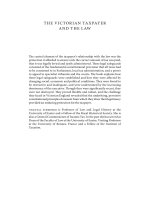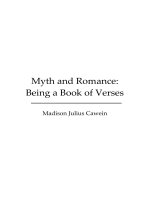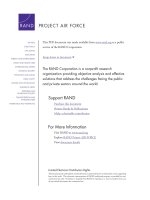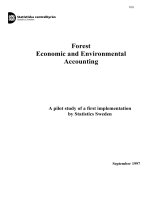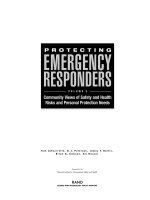pipe line corrosion and cathodic protection a field manual
Bạn đang xem bản rút gọn của tài liệu. Xem và tải ngay bản đầy đủ của tài liệu tại đây (7.11 MB, 177 trang )
Pipe Line
Corrosion
Cathodic
Protection
THIRD
EDITION
/
Gulf
Professional Publishing
an
imprint
of
Butterworth-Heinemann
Pipe
Line
Corrosion
^^^—and-^^—
Cathodic
Protection
A
practical manual
lor
corrosion engineers,
technicians,
and
field
personnel
THIRD
EDITION
Marshall
E.
Parker
Edward
G.
Peattie
Gulf
Professional Publishing
and
Butterworth-Heinemann
are
imprints
of
Elsevier
Science.
Copyright
©
1999
by
Elsevier Science (USA).
All
rights
reserved.
Originally
published
by
Gulf Publishing Company, Houston,
TX.
No
part
of
this publication
may be
reproduced,
stored
in a
retrieval system,
or
transmitted
in any
form
or by any
means, electronic, mechanical,
photocopying, recording,
or
otherwise, without
the
prior written permission
of
the
publisher.
Permissions
may be
sought directly
from
Elsevier's
Science
&
Technology
Rights Department
in
Oxford,
UK:
phone: (+44) 1865
843830,
fax: (+44)
1865
853333,
e-mail:
You may
also complete
your request on-line
via the
Elsevier Science homepage
(),
by
selecting
'Customer
Support'
and
then
'Obtaining
Permissions'.
This book
is
printed
on
acid-free paper.
Library
of
Congress
Cataloging-in-Publication
Data
Parker, Marshall
E.
Pipe line corrosion
and
cathodic protection.
Includes index.
ISBN
0-87201-149-6
1.
Pipelines—Corrosion
2.
Pipelines—Cathodic
protection.
I.
Peattie,
Edward
G. II.
Title
TJ930.P33 1984
621.8'672
83-22630
The
publisher
offers
special discounts
on
bulk orders
of
this book.
For
information,
please
contact:
Manager
of
Special
Sales
Elsevier Science
200
Wheeler Road
Burlington,
MA
01803
Tel:
781-313-4700
Fax:781-313-4802
For
information
on all
Gulf
publications
available, contact
our
World Wide
Web
homepage
at
/>10
9 8 7 6
Printed
in the
United States
of
America.
iv
Contents
Preface
to
Third Edition
vii
Preface
to
First
Edition
ix
1
Soil Resistivity Surveys
1
Soil Resistivity
Units.
Two-Terminal Resistivity Determination. Four-
Terminal
Resistivity Determination. Other Methods. Locating
Hot
Spots
on
Bare Lines. Surveys
for
Ground Beds. Area Surveys. Loga-
rithmic
Resistivity Ranges. Summary.
2
Potential
Surveys
16
Pipe-to-Soil
Potentials: Electrodes. Electrode Placement. Pipe Line
Connection. Surface Potential Survey
for
Corrosion.
Pipe-to-Soil
Po-
tential
as a
Criterion
of
Cathodic Protection. Other Applications
of
Pipe-to-Soil
Potentials.
Other Criteria. Summary.
3
Line Currents
31
Measurement
of
Line Current
in
Test
Section.
Stray-Current Studies.
Long-Line
Currents. Cathodic Protection Tests. Coating Conductance
Measurement. Summary.
4
Current Requirement Surveys
36
The
Problem: Coated Lines. Principles
of
Current Requirement
Test.
Current
Sources
for
Tests. Temporary Ground Beds. Special Condi-
tions. Summary.
5
Rectifier Systems
for
Coated
Lines
45
General Design
Principles.
Attenuation Curves. Line
Termination.
An-
ode
Proximity
Effects.
Attenuation with Multiple Drain Points. Design
Procedure.
An
Alternate Method.
The
Economic Balance. Summary.
v
6
Ground
Bed
Design
and
Installation
59
Design Principles. Disturbing Factors. Field Modification. Installation
Methods. High-Silicon Iron Anodes. Steel Anodes. Horizontal Graph-
ite
Anodes.
Deep
Anodes.
A
Typical Ground
Bed
Installation. Sum-
mary.
7
Galvanic Anodes
on
Coated Lines
78
When
and
Where
to Use
Magnesium. When
and
Where
to Use
Zinc.
General System Design. Installation Procedure. Polarization
and
Final
Adjustment.
Modification
of
Process
with
Experience. Sample Prob-
lems. Summary.
8 Hot
Spot Protection
88
What
"Hot
Spots"
Are.
Hot
Spot Protection. Locating
Hot
Spots.
An-
ode
Selection
and
Spacing. Field Installation. Field Design. Zinc
An-
odes
in Hot
Spot Protection. Installation Details. Supervision
and
Con-
trol. Summary.
9
Stray-Current Electrolysis
100
Stray Current
Corrosion.
Sources
of
Stray Currents. Detection
of
Stray
Current. Remedial Measures. Negative
Bus
Bonding. Exposure Areas.
Potential Surveys. Secondary Exposure. Summary.
10
Interference
in
Cathodic
Protection
109
The
Problem. Basic Solutions. Design. Crossing Bonds. Calculation
of
Bond
Resistance. Multiple Bonds.
Auxiliary
Drainage. Parallel Lines.
Radial-Flow Interference. Foreign Lines with Insulating Joints. Sum-
mary.
11
Operation
and
Maintenance
125
Importance
of
Adequate Supervision. Failures
in
Rectifier-Ground
Bed
Systems.
Failures
in
Magnesium Anode Systems. Minimum Inspection
Schedule
for
Rectifier System. Minimum Inspection Schedule
for An-
odes.
Monitor System.
Troubleshooting.
Summary.
12
Coating Inspection
and
Testing
136
Construction
Inspection. Evaluation
of
Coating
in
Place. Coating
or
Leakage Conductance. Pearson Surveys. Accelerated Coating Tests.
Summary.
Appendix
A
Fundamentals
of
Corrosion
146
Appendix
B
Cathodic Protection
of
Steel
in
Soil
150
Appendix
C
Corrosion
of
Steel
in
Soil
153
Appendix
D
Attenuation Equations
160
Index
163
vi
Preface
to
Third Edition
A
pipe line buried
in the
earth
represents
a
challenge.
It is
made
of
steel—a
strong,
but
chemically
unstable,
material—and
is
placed
in an
environment
which
is
nonuniform, nonprotective,
and
nonyielding.
It is
the
duty
of the
corrosion engineer
to
study
the
properties
of
this system
to
ensure that
the
pipe
line will
not
deteriorate.
In
1955,
when
I was
first
working
on
cathodic protection
for
pipe
lines
in
Saudi Arabia,
the
first
edition
of
this
book
by
Marshall Parker
was
just
a
year old. Fortunately,
the
company library contained
Mr.
Parker's book.
I
found
its
simplicity
and
directness preferable
in ap-
proaching
a
complex subject.
During
the 30
years since
its
publication, generations
of
pipe line
en-
gineers
and
technicians have used this book
as
their
first
exposure
to
corrosion control. Many books
on the
subject have been published since
1954,
but the
Parker book
is
still
the
best introduction
to the
fundamen-
tals.
New
technology
has
been developed,
yet the
principles
of
cathodic
protection
are
still
the
same.
The
result
is
that
we
have more sophisti-
cated
instruments
to
use,
but the
measurements have
not
changed.
Con-
sequently,
I
have retained
the
still-valid material
of the
original Marshall
text
and
made changes only when better
and
shorter methods
are
avail-
able.
The
first
task
of the
pipe line corrosion engineer
is to
study
the
prop-
erties
of the
earthen environment. First,
we
shall learn
how to
measure
the
resistivity
of the
soil
as a
preparation
for
further
work.
In the
second
vii
chapter
we
shall study another electrical measurement: potential
differ-
ence.
To do
this,
we
shall learn about
the
standard electrode
for
this
measurement.
In
Chapter
3 we go on to
line currents
and
extend these
measurements
to
current requirement surveys
in
Chapter
4.
Thus,
the
current
necessary
to
design
a
cathodic
protection
system will
be
calcu-
lated.
Chapters
5 and 6
show
the
computations required
for the
design
of an
impressed current cathodic protection system. Then, Chapter
7
shows
the
design
procedure
for a
sacrificial
cathodic
protection
system.
The
problem
of
partial cathodic protection
of a
pipe line
by
concen-
trating
on
"hot
spots"
is
discussed
in
Chapter
8. A
problem
in
Chapter
9,
which
does
not
usually occur nowadays,
is
that
of
stray-current cor-
rosion; however,
a
corrosion engineer should still
be
able
to
identify
this
phenomenon
and
find
its
source.
Interference (Chapter
10) is a
problem
corrosion engineers face every
day and are
still
learning about.
The
last
two
chapters
of the
book (Chapters
11
and
12)
show
the op-
eration
and
maintenance
of a
cathodic protection system,
and how to
evaluate
the
coatings system
in
place.
The
Appendixes
contain
material
basic
to the
knowledge
of all
corrosion engineers.
At
the end of
this
book,
the
reader
will
be
well
on the way to
being
a
capable corrosion engineer.
Edward
G.
Peattie
Professor
of
Petroleum
Engineering
Mississippi State University
vlii
Preface
to
First Edition
How
do
people become pipe line corrosion engineers?
Not by
obtain-
ing
a
degree
in the
subject,
for no
such degree
is
offered. Many corro-
sion engineers hold
degrees—in
chemistry, chemical engineering,
elec-
trical
engineering,
or any one of
several
others.
Many others either have
no
degree,
or
have studied
in
some field apparently
or
actually remote
from
corrosion.
All of
these
men
became corrosion engineers
by
on-the-
job
experience
and by
individual
study—some
by
trial-and-error
meth-
ods, having been assigned
the
responsibility
of
protecting
some
struc-
ture
from
corrosion; some
by
working
with
people already experienced.
That this should
be the
case
is not
surprising, particularly when
the
protection
of
underground structures against corrosive attack
is
still
as
much
an art as it is a
science. Say, rather, that
it is a
technology; most
of
the
design procedures used
are
either empirical,
or, at
best,
are
based
on
empirically
modified theory. Almost every cathodic protection system
installed
has to be
adjusted,
by
trial,
to do its job
properly.
It is
common
experience
that
no two
jobs
are
alike; every
new
project contains some
surprises, some conditions
not
previously encountered.
These
things
are
true
for two
main
reasons.
First,
we do not as yet
know
enough about
the
subject; there
is
still
room
for the
development
of
more
powerful
analytical methods. Second,
the
soil
is a
bewilder-
ingly
complex environment,
and
structures placed therein
affect
one an-
other
in
very complicated ways. Almost never
can we
measure directly
a
single quantity which
we
seek;
what
our
meters usually indicate
is the
ix
result
of
what
we are
looking
for and a
number
of
partially unknown
disturbing
factors.
The
corrosion
engineer, then, must
be to a
large extent self-trained.
And
he can
never expect
to
complete
that training. This manual
is an
attempt
to
present
some
workable methods
of
doing some
of the
things
the
pipe line corrosion engineer
is
called upon
to do. In no
case
is the
method given necessarily
the
method;
it is
merely
one
method.
If, by
use of
this
manual,
some
corrosion
engineers
avoid
some
of the
pitfalls
into
which
I
have fallen,
and
save time
and
effort
in
obtaining
and
inter-
preting field data, then
I
will
be
happy that
my
time
has
been well spent
setting down some
of the
experience—a
small part
of
which
has
been
his
own,
a
very
large
share
of
which
is
that
of
many
others—and
thus
providing,
in a
way,
a
shoulder
to
look over.
Marshall
E.
Parker
Houston, Texas
January
18,
1954
x
1
Soil
Resistivity Surveys
Pipe lines
may be
cathodically protected
in
either earth
or
water.
To
determine
if
cathodic protection
may be
used
to
prevent corrosion
of
steel pipe lines,
we
must first learn
how to
measure
the
resistivity
of
these environments.
Soil
Resistivity
Units
The
unit
of
soil
resistivity
is the
ohm-centimeter, usually abbreviated
ohm-cm;
the
resistivity
of a
given soil
is
numerically equal
to the
resis-
tance
of a
cube
of the
soil
one
centimeter
in
dimensions,
as
measured
from
opposite faces (Figure
1-1).
The
resistance
of a
rectangular solid
other
than
a
cube
is
given
by
where
W,
L, and D are the
dimensions
in
centimeters,
as
shown
in
Fig-
ure
1-1,
and p is the
resistivity;
the
unit must
be
ohm-cm
in
order
for the
equation
to be
consistent.
The
resistance between
any two
terminals,
of
any
size
and
shape,
in
contact with
a
body
of
soil,
of any
extent,
is de-
termined
by the
size
and
spacing relationships
and by the
resistivity
of
the
soil.
For
simple cases,
the
resistance
can be
computed,
but the
math-
ematical complexities
are
often very great.
1
Figure
1-1.
(a)
Resistivity
(@)
in
ohm-cm
is
numerically
equal
to the re-
sistance
(R) in
ohms
between
opposite
faces
of a
cube
one cm on the
side,
(b)
Resistance
of a
rectangular
solid,
(c)
Soil
box,
in
which
Q
is ob-
tained
by
measuring
the
resistance
between
the
planes
of the two po-
tential
pins.
Two-Terminal
Resistivity
Determination
An
apparatus similar
to
that illustrated
in
Figure
1-1
may be
used
to
determine
the
resistivity
of
soil samples;
in
corrosion investigations,
however,
it is
much more
useful
to
measure
the
soil
in
place.
If
two
terminals
are
placed
in the
soil,
then
it
will
be
possible
to
deter-
mine
its
resistivity
by
measuring
the
resistance between
the two
elec-
trodes.
If
they
are
placed close together,
it
will
be
necessary
to
maintain
a
known
and
fixed distance between them;
if
they
are far
enough apart,
surprisingly
enough,
the
indicated value
is
virtually
independent
of the
distance. Either
AC or DC may be
used,
and the
resistance
may be de-
2
Pipeline Corrosion
and
Cathodic
Protection
Soil
Resistivity Surveys
3
Figure 1-2. Shepard canes
for
soil resistivity measurement. Current
from
a
three-volt battery (two flashlight cells)
is
passed through
the
soil
between
two
iron electrodes mounted
on
insulating
rods. Current flow
is
measured
by a
double range milliammeter (0-25
and
0-100)
graduated
to
read directly
in
ohm-cm
(10,000-400
and
500-100).
Cathode
is
made
larger
to
avoid
polarization;
accuracy
is
about 6°/o when tips
are
sepa-
rated
by 8
inches
or
more. Meter,
batteries,
and
switch
are
mounted
on
anode
rod.
termined
by
measuring current
and
potential,
or by a
bridge
circuit,
in
which
the
unknown resistance
is
compared
to one
which
is
within
the
instrument.
Figure
1-2
illustrates Shepard canes, which
use DC
impressed
be-
tween
two
iron
electrodes.
This apparatus
is
rapid
in
use,
but
gives
the
value
corresponding
to a
small sample
of
soil,
in the
immediate neigh-
borhood
of the
electrodes. Figure
1-3
shows
an AC
bridge-type appa-
ratus; this
device
is
also
very rapid
in
use,
but it,
too, measures only
a
small
sample. Numerous variations
of the
latter
are on the
market.
Four-Terminal
Resistivity
Determination
To
include
a
larger sample
of the
soil
and
measure
the
resistivity
at
greater depths,
the
four-terminal
or
Wenner method
may be
used.
The
basic circuit
is
shown
in
Figure
1-4;
the
following figures (Figures 1-5,
1-6,
and
1-7) show some
of the
specific methods based
on
this tech-
nique. Details
of
operation
vary with
the
particular instrument
used,
but
4
Pipeline Corrosion
and
Cathodic
Protection
Figure 1-3.
AC
soil rod. Current from
an AC
source (usually
a
battery,
buzzer,
and
condenser)
is
passed through
the
soil between
a
steel
rod
and
an
insulated
steel tip.
The
slidewire
is
then adjusted
until
no
signal
is
heard
in the
headphones;
at the
point
of
balance
In
practice,
the
slidewire
R
A
R
B
is
graduated
to
read
R
directly; then
Q
= R -
C,
where
C is a
constant
for the
particular
rod,
determined
by
calibration
in a
solution
of
known resistivity.
Figure 1-4. Four-terminal
(Wenner)
measurement
of
soil resistivity. Dis-
tance
(b), depth
of
electrode, must
be
small compared
to
(a).
The
basic
formula
is
The
resistivity
is
"averaged"
to a
depth approximately equal
to the
elec-
trode spacing (a).
So/7
Resistivity Surveys
5
Figure
1-5.
Ammeter-voltmeter
measurement
of
resistivity.
A
storage
battery
of dry
cells
may be
used
for
current.
Copper
sulfate
electrodes
will
help
avoid
polarization
errors.
The
voltmeter
used
must
be
high
re-
sistance,
or a
potentiometer
may be
employed.
If the
distance
(a) is
made
5
feet,
2
1
A>
inches,
then
the
formula
simplifies
to
Direction
of
current
should
be
reversed,
and
readings
averaged,
to
bal-
ance
out
extraneous
currents
or
potentials
in the
soil.
the
principle
is
common
to
all.
It
should
be
noted that
the
resistance
measured
is
that between
the two
inner,
or
potential, electrodes;
the
outer pair serve
to
introduce
the
current into
the
soil.
The
value obtained
is an
"average"
value
to a
depth approximately
equal
to the
electrode
spacing; actually,
it is
influenced
to
some degree
by
soil lying
at
even greater depths. There
is no
sharp dividing line,
but
the
influence
of
soil
at
greater
and
greater depths becomes smaller
and
smaller.
Other
Methods
There
are at
least three possible indirect methods
of
measuring soil
resistivity
in
which
no
contact
is
made
with
the
soil
at
all.
An
induction-
type
pipe locater gives
an
indication
of the
resistivity below
it and may
be
calibrated
to
yield
fairly
accurate results.
In
general, this method
may
be
very
useful
in
scouting
out
low-resistivity areas, which
can
then
6
Pipeline Corrosion
and
Cathodic
Protection
Figure
1-6.
Vibroground
(simplified
diagram).
Vibrators
V,
and
V
2
are
synchronized;
Vi
converts
the
battery's
DC
into
AC; the
slidewire
S is
adjusted
until
the
IR
drop
across
R,
just
bucks
out the
current
in the po-
tential
circuit,
as
indicated
by a
zero
deflection
on the
galvanometer
G;
R
is
then
read
directly
on the
slidewire,
and
Q
is
obtained
from
Q
=
2xaR.
be
explored more precisely
by one of the
methods already described.
The
value
and
phase angle
of the
impedance (high-frequency)
be-
tween
two
parallel conductors lying
on or
parallel
to the
surface
is a
function
of the
soil
resistivity,
and
thus
a
device could
be
built which
would
employ this principle.
It is
also true that
the
tilt
of the
radiation
field
of a
remote radio transmitter
at the
surface
of the
earth
is a
func-
tion
of the
soil resistivity. Both
of
these methods offer some promise
of
development into very rapid
and
possibly automatic systems
for the re-
cording
of
resistivity,
but the
development
has not yet
been done.
Locating
"Hot
Spots"
on
Bare
Lines
Bare lines, particularly gathering lines,
are
often
so
situated that
the
point
of
maximum economic return
for
cathodic
protection
is not the
prevention
of all
leaks,
but the
prevention
of
85-95%
of
them. This
can
Soil Resistivity Surveys
7
often
be
done
at a
cost
as low as 15% of
that
of
full
protection
by the
application
of
galvanic
anodes—usually
magnesium—to
the
"hot
spots''
or
areas
of
maximum corrosiveness. This
has
been shown
to
cor-
relate highly with resistivity
so
that
a
system
of
locating areas
of
low,
and
of
relatively
low,
resistivity,
is the
indicated technique. Such
a
pro-
cedure
is
known
as a
soil resistivity survey,
and
consists
of a
series
of
measurements
taken along
the
line
(or
right-of-way
for a
planned line),
using
any of the
methods described.
The
four-point method
is
most
commonly used.
Readings should
be
taken according
to a
systematic procedure; there
is
some
conflict
here between
the
demands
of
science
and
those
of
prac-
ticality.
If
readings
are
taken
at
uniform
spacing,
the
statistical analysis
of
the
entire
set
will
be
more representative
of the
corrosive conditions
along
this line,
as
compared
to
other lines.
In
other words, such
a
proce-
dure
will give
the
maximum
of
general information.
The
maximum
of
useful
information, however
useful
in the
design
of a hot
spot protective
Figure 1-7. Soil resistivity Megger (simplified diagram).
DC
from
the
hand-cranked generator
G
is
converted
to AC by the
commutator
C
c
,
and
enters
the
soil
through
C
1
and
C
2
,
after passing through
the
current
coil;
the AC
potential picked
up
between
P
1
and
P
2
is
converted
to DC by
commutator
C
p
and is fed to the
potential
coil.
The
needle comes
to
rest,
under
the
opposing forces from
the two
coils,
at a
point which indicates
the
resistance
R.
Q
is
then obtained from
Q
=
2iraR
8
Pipeline Corrosion
and
Cathodic Protection
system,
is not
obtained
in
this way,
but
rather
by
some
such method
as
the
following:
1.
A
reading
to be
taken
at
least every
400
feet.
2. A
reading
to be
taken wherever there
is a
visible change
in
soil
characteristics.
3. Two
successive readings should
not
differ
by a
ratio greater than
2:1
(when
a
reading
differs
from
the
preceding
by
more than this,
then
it is
necessary
to go
back
and
insert
a
reading; this should
be
repeated
until
condition
3 is
met).
4. As an
exception
to the
last
rule,
no two
readings
need
be
taken
closer than
25
feet.
5.
As
another exception
to the
2:1
rule,
it
does
not
apply when
the
lower
of the two
readings
is
greater than
20,000
ohm-cm.
The
fig-
ures given
in
this
set of
criteria
may be
varied
for-specific
cases;
the
foregoing
set has
been
found
useful
and
economical
in the
sur-
vey of
over
a
million
feet
of
gathering lines.
For
this type
of
survey, readings would
be
taken which correspond
to
the
soil
at
pipe depth. This means that holes will have
to be
drilled
or
punched
for the
single-rod
apparatus.
The
four-terminal
system
should
be
used with
a
spacing
of
about
1
'/2
times pipe depth; very often
a 5-
foot,
2'/2-inch
spacing (which makes
the
multiplier
2ira
just equal
to
1000)
is
well suited
for
this purpose.
Data obtained
in the
survey
are
plotted
on a
diagram representing
the
length
of the
line,
as
illustrated
in
Figure 1-8.
The
vertical resistivity
scale
is
logarithmic, since resistivity ratios
are of
interest, rather
than
their
differences. From such
a
diagram
the
"hot
spots"
can
readily
be
located. This technique
will
be
discussed more
fully
in a
subsequent
chapter.
Surveys
for
Ground
Beds
The
resistivity
of the
soil
in
which
a
ground
bed is to be
installed
is
one of the
primary design quantities involved.
It is
most important
to
get as low a
total resistance
as
possible
in
order
to
obtain
the
necessary
current
output with
the
minimum amount
of
power. Unlike
the
survey
to
determine
corrosiveness,
as in the
preceding topic,
in
this case
the
Figure 1-8. Soil resistivity profile. Measurements taken
by any of the
methods described
are
plotted
as
ordinates
(using
a
logarithmic
scale),
with
distances along
the
pipe
line
as
abscissas.
resistivity
to
great depth
is
important.
For
this reason,
the
four-terminal
method
is the
only
one
useful
here.
It is
customary
to
take readings
at
5-,
10-,
and
20-foot
pin
spacing (actual values used
are 5
feet,
2
l
/2
inches;
10
feet,
5
inches;
and 20
feet,
10
inches; giving multipliers
of
1000,
2000,
and
4000,
respectively).
The
prospective site should
be
marked
off in a
rectangular grid, with
spacings
of 50 or 100
feet,
and
readings
taken
at
each grid intersection;
where differences
are too
great, intermediate readings should
be
taken.
Soil
Resistivity Surveys
9
10
Pipeline Corrosion
and
Cathodic
Protection
These
diagrams should always
be
plotted
in the
field
so
that
a
complete
picture
will
be
obtained.
"Contours"
can be
drawn,
as
indicated
in
Fig-
ure
1-9.
If
colors
are
used,
the
readings
at all
three
pin
spacings
can be
put
on the
same diagram; only
one is
shown
here.
Note that
the
values
chosen
for
contours
are
logarithmic,
as
were
the
vertical scales
in the
line resistivity survey.
Area Surveys
Where
a set of
piping
and
other underground structures
is
spread
out
over
an
area,
as in a
refinery
or
chemical plant,
a
survey similar
to the
one
just described will
furnish
information
useful
both
in the
prediction
of
corrosiveness
and in the
design
of
protective systems.
The
spacing
used between readings
is
usually greater
than
for
ground
bed
design.
A
Figure 1-9. Resistivity
plat.
Resistivity readings taken
at
spaced inter-
vals, with
additional
readings
at
critical
points,
are
indicated
by the
small
figures.
The
curves represent
lines
of
equal resistivity. Such plats
are of
value
in
locating sites
for
ground
beds
and in
their design.
Soil
Resistivity
Surveys
11
Figure 1-10.
Resistivity
histogram. Equally spaced resistivity readings
taken
over
an
area
or
along
a
pipe
line
route
are
plotted according
to the
frequency
of
occurrence
of
readings
in the
different ranges. Note that
successive
ranges cover equal resistivity ratios, rather than arithmetic
differences.
preliminary
spacing
of 400
feet
is
often used, with intermediate posi-
tions used where necessary
to get a
clear picture.
As in the
ground
bed
survey,
readings
are
usually displayed
on a
resistivity contour
map of
the
plant site. Usually only
one pin
spacing
is
used,
and the
most fre-
quent
value
is the
nominal five-foot spacing already mentioned.
In
addition
to the
geographical distribution shown
on the
resistivity
plat,
it is
useful
to
prepare
a
histogram,
or
frequency distribution,
as
indicated
in
Figure 1-10. This shows
the
number
of
readings found
in
various
"classes"
or
ranges
of
resistivity; these ranges should
be
loga-
rithmic,
as are the
contour intervals
on the
plat already described.
Logarithmic
Resistivity
Ranges
Three examples have already been given
of
logarithmic treatment
of
resistivities.
There
is
sound scientific basis
for
this approach, aside
from
the
intuitive observation that ratios
are
more important than
differ-
ences.
It has
been found that large numbers
of
resistivity readings, when
expressed
as
logarithms, tend
to
fall
into
"standard"
distributions.
The
12
Pipeline Corrosion
and
Cathodic
Protection
standard distribution
is a
well-known
and
extremely
useful
concept
in
statistical analysis.
A
consequence
of
this
is
that
two
extensive structures (such
as
pipe
lines) each exposed
to a
wide variety
of
soils
can be
compared
as to
their
corrosion exposure most accurately
by
comparing their logarithmic
mean
resistivities.
The
logarithmic mean resistivity
of a set of
resistivi-
ties
is the
value whose logarithm
is the
average
of all the
logarithms
of
the
measured values.
These
can
most easily
be
averaged
by
grouping
them into
classes,
as
shown
in
Figure
1-11,
where
the
logarithmic mean
of
115
different
readings
is
found
to be
14,900
ohm-cm.
It is
almost universal practice
to
choose
a
ratio
of
2:1
for the
succes-
sive values used
in any
logarithmic system,
for
contours, histograms,
or
the
calculation
of a
mean. Three
different
systems
are in
widespead use:
the
two
already illustrated
(A)
based
on 100
ohm-cm,
as
used
in
Figures
1-9
and
1-10;
(B)
based
on
1000 ohm-cm,
as
used
in
Figure
1-11;
and (C)
which
is not
truly logarithmic,
in
that
the
ratio
is not al-
ways
the
same.
All
three
are
shown here
for
comparison:
(A)
(B) (C)
50
62.5
50
100 125 100
200 250 200
400 500 500
800
1,000
1,000
1,600
2,000 2,000
3,200
4,000 5,000
6,400 8,000 10,000
Scale
(C) has the
advantage
in
that
all of the
values
are
"round"
numbers whereas
if
either
(A) or (B) is
extended
far
enough
in
either
direction,
the
numbers tend
to
become awkward.
On the
other hand,
when
a
mathematical analysis
is
made
of the
data,
the
irregular ratios
involved
in
scale
(C)
introduce complications. Note,
when
(C) is
used
for
a
histogram,
the
horizontal widths
of the
"cells"
should
be
made
proportional
to the
logarithms
of the
ratios.
Log 2 =
0.301,
log 2.5 =
0.398;
so the
ratio
of the two
spaces
should
be
about 3:4.
The
corrosion technician
now has
various methods
at his
disposal
to
measure
the
resistivity
of the
soil
in
which
the
pipe line
is to be in-
Soil
Resistivity Surveys
13
Figure
1-11.
Summary
of
soil
resistivity measurements.
stalled.
The
question
may now be
asked: What
if the
pipe line
is to be
installed
in
water—would
the
same methods
of
measurement work?
The
answer
is
yes,
but
with reservations. Actually,
a
single sample
of
the
water
is
enough,
and it can be
measured
in a
soilbox,
as
shown
in
Figure
1-12.
The
countless variations
of
resistivity which
we
have
shown
in
Figure
1-9 for
soil
do not
exist
in the
water environment,
and
so one
resistivity value
in
ohm-centimeters
is
usually enough
for the en-
gineer
to
use.
For
soils,
as we
have seen,
it is
more complicated.
14
Pipeline
Corrosion
and
Cathodic
Protection
Figure 1-12. Typical connections
for use of
soil
box
with various
types
of
instruments. (Courtesy
of M. C.
Miller Co., Inc.)

